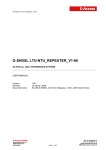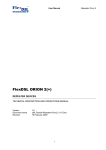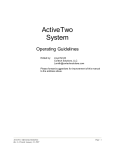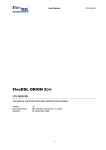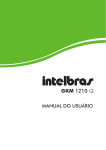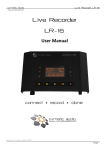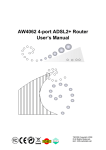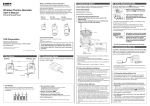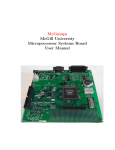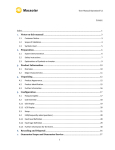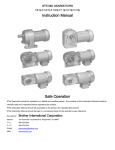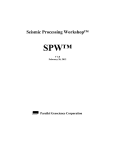Download S-Access 2W-SAN/IP-REPEATER
Transcript
SA-PAM-RGN 2W-PL/IP-REPEATER SA-PAM-RGN-xx-x xDSL TRANSMISSION SYSTEMS USER MANUAL Version Revision Document name Version: 1.1 1.1 15 August 2005 UM_S-Access_2W-Repeater_v1-1.doc Page. 1 of 34 SA-PAM-RGN User Manual © Copyright ©2005 by S-Access GmbH. The contents of this publication may not be reproduced in any part or as a whole, transcribed, stored in a retrieval system, translated into any language, or transmitted in any form or by any means, electronic, mechanical, magnetic, optical, chemical, photocopying, manual, or otherwise, without the prior written permission of S-Access GmbH. Published S-Access GmbH. All rights reserved. Version: 1.1 Page. 2 of 34 SA-PAM-RGN User Manual VERSION CONTROL .................................................................................................................. 6 1 SELECTION GUIDE ............................................................................................................. 6 2 UNITS DESCRIPTION.......................................................................................................... 7 2.1 2.2 2.3 2.4 3 IP HOUSING..................................................................................................................... 7 PLASTIC HOUSING ........................................................................................................... 7 CONNECTORS MAINBOARD .............................................................................................. 8 JUMPER / PASSTHROUGH RESISTOR DESCRIPTION ........................................................... 9 CONFIGURATION / ACCESS.............................................................................................. 9 3.1 REPEATER XDSL INTERFACES ......................................................................................... 9 3.1.1 N-side / C-side xDSL interface operating modes...................................................... 9 4 LED INDICATORS.............................................................................................................. 10 4.1 4.2 4.3 5 TDM REGENERATOR...................................................................................................... 10 TDM ADRE1 REPEATER ................................................................................................ 10 ATM REGENERATOR ...................................................................................................... 10 ALARMS............................................................................................................................. 11 5.1 GENERAL INFORMATION ................................................................................................. 11 5.2 ALARM RELAYS ............................................................................................................. 11 5.2.1 Relay - Alarm Conditions ........................................................................................ 11 5.3 ALARM LEDS ................................................................................................................. 11 5.3.1 LED - Alarm Conditions .......................................................................................... 11 5.3.1.1 Local (NE) LED ............................................................................................... 11 5.3.1.2 Remote (FE) LED ........................................................................................... 12 6 TEST LOOPS ..................................................................................................................... 13 6.1 REGENERATOR TEST LOOP ............................................................................................ 13 6.2 ADRE1 REPEATER TEST LOOPS .................................................................................... 13 6.2.1 Loop1 & Loop2 ....................................................................................................... 13 6.2.2 Analog Loopback .................................................................................................... 13 7 PERFORMANCE MONITORING........................................................................................ 14 7.1 7.2 8 POWER............................................................................................................................... 15 8.1 8.2 8.3 9 TDM REPEATERS........................................................................................................... 14 ATM REPEATERS ........................................................................................................... 14 POWER INPUTS .............................................................................................................. 15 WETTING CURRENT ........................................................................................................ 15 REMOTE POWER PASSTHROUGH .................................................................................... 15 MONITOR ........................................................................................................................... 16 9.1 GENERAL ...................................................................................................................... 16 Version: 1.1 Page. 3 of 34 SA-PAM-RGN User Manual 9.2 STRUCTURE & ORGANIZATION ....................................................................................... 16 9.3 REPEATER COMMAND TREE ............................................................................................ 17 9.3.1 TDM regenerator .................................................................................................... 17 9.3.2 TDM ADRE1 repeater............................................................................................. 17 9.3.3 ATM regenerator..................................................................................................... 18 9.3.4 Main Menu .............................................................................................................. 18 9.3.5 Common Commands.............................................................................................. 19 9.3.5.1 HELP Command ............................................................................................. 19 9.3.5.2 MAIN Command ............................................................................................. 19 9.3.6 Performance management PM............................................................................... 19 9.3.6.1 G826 Command.............................................................................................. 19 9.3.6.2 G826 E1 Command ........................................................................................ 20 9.3.6.3 RESETG826 Command.................................................................................. 20 9.3.7 Fault and maintenance management FMM ............................................................ 21 9.3.7.1 SQ Command ................................................................................................. 21 9.3.7.2 NM Command................................................................................................. 21 9.3.7.3 STARTUP Command...................................................................................... 21 9.3.7.4 STATUS Command ........................................................................................ 22 9.3.7.5 ALARM Command .......................................................................................... 23 9.3.7.6 LOOP1 Command .......................................................................................... 24 9.3.7.7 LOOP2 Command .......................................................................................... 24 9.3.7.8 STARTAL Command ...................................................................................... 24 9.3.7.9 RESTART Command...................................................................................... 24 9.3.7.10 Spectrum Command...................................................................................... 25 9.3.7.11 RESET Command ......................................................................................... 25 9.3.8 Configuration management CM.............................................................................. 26 9.3.8.1 CONFIG Command ........................................................................................ 26 9.3.8.2 ADAPTIVE Command..................................................................................... 26 9.3.8.3 ANNEX Command .......................................................................................... 26 9.3.8.4 AUTORESTART Command............................................................................ 26 9.3.8.5 BASERATE Command ................................................................................... 26 9.3.8.6 DEFAULT Command ...................................................................................... 26 9.3.8.7 DEFAULT Command (ATM version) .............................................................. 26 9.3.8.8 MODE Command............................................................................................ 27 9.3.8.9 ID Command................................................................................................... 27 9.3.8.10 IDLECAS Command...................................................................................... 27 9.3.8.11 PAYLOAD Command .................................................................................... 27 9.3.8.12 PCM Command ............................................................................................. 27 9.3.8.13 SCALE Command ......................................................................................... 27 10 SOFTWARE UPDATE .................................................................................................... 28 10.1 10.2 11 GENERAL ................................................................................................................. 28 SOFTWARE DOWNLOAD ............................................................................................ 28 CONNECTOR DESCRIPTION........................................................................................ 32 Version: 1.1 Page. 4 of 34 SA-PAM-RGN 11.1 11.2 11.3 11.3.1 11.4 11.4.1 11.4.2 11.5 11.6 11.6.1 11.6.2 11.7 12 User Manual XDSL INTERFACE ..................................................................................................... 32 MONITOR INTERFACE................................................................................................ 32 POWER INTERFACE................................................................................................... 32 Cable .................................................................................................................. 32 INTERFACES ............................................................................................................. 33 xDSL Line Interface ............................................................................................ 33 Monitor Interface................................................................................................. 33 POWER SUPPLY ....................................................................................................... 33 ENVIRONMENTAL ...................................................................................................... 33 Climatic Conditions ............................................................................................. 33 Safety / EMC....................................................................................................... 33 PHYSICAL DIMENSIONS AND WEIGHT......................................................................... 34 APPENDICES ................................................................................................................. 34 12.1 12.2 INITIALIZATION ERRORS ............................................................................................ 34 STANDARDS ............................................................................................................. 34 FIGURES Figure 8-1: Repeater Monitor Command Set Tree..................................................................... 17 Version: 1.1 Page. 5 of 34 SA-PAM-RGN User Manual VERSION CONTROL User Manual Date Version 1.0 11.02.2005 1.1 15.08.2005 Version of Firmware 1.6.6.26 1.6.S.2 1.6.6.26 1.6.S.4 Major changes to previous version Start Version TDM Start Version ATM None New T1 mode Warnings INCORRECT USE OF THIS DEVICE, USE IN ANY OTHER ENVIRONMENT AND/OR CHASSIS/HOUSING THAN PROVIDED BY S-ACCESS MIGHT LEAD TO HARMFUL CONDITIONS. FAILURE TO FOLLOW THESE PRECAUTIONS MAY RESULT IN DEATH, SEVERE INJURY OR PROPERTY DAMAGE. S-ACCESS GMBH REFUSES TO TAKE ANY RESPONSIBILITY; FURTHERMORE, NO WARRANTY IS GRANTED IN SUCH CASE! Please read this manual carefully before operating the system. Installation of this equipment has to be done by qualified personnel only. SA-PAM-RGN-IP-E,V2 IP SA-PAM-RGN-PL-E,V2 SAN SA-PAM-RGN-PL-P,V2 SAN SA-PAM-RGN-IP-E,V2n IP SA-PAM-RGN-IP-P,V2n IP SA-PAM-RGN-PL-E,V2n SAN SA-PAM-RGN-IP-E-ATM,V2 IP ATM SA-PAM-RGN-PL-E-ATM,V2 SAN ATM SA-PAM-RGN-PL-P-ATM,V2 SAN ATM IP SA-PAM-ADRE1-PL-E,V2 SAN SA-PAM-ADRE1-PL-P,V2 SAN Page. 6 of 34 Power source Remotely powerable Power Passthrough VC12 Nx64 ATM T1 E1 Cross Connect IP SA-PAM-ADRE1-IP-P,V2 Version: 1.1 Add Drop SAN IP ATM SA-PAM-RGN-IP-P-ATM,V2 SA-PAM-ADRE1-IP-E,V2 4 wire IP SA-PAM-RGN-IP-P,V2 SA-PAM-RGN-PL-P,V2n 2 wire M odel Type 1 SELECTION GUIDE SA-PAM-RGN User Manual 2 UNITS DESCRIPTION The units are designed to be used as dual wire TDM or ATM repeater. They are available in a IP67 or plastic housing. 2.1 IP Housing 2.2 Plastic Housing Version: 1.1 Page. 7 of 34 SA-PAM-RGN 2.3 User Manual Connectors Mainboard DSL Connector NE Led FE Led Power Switch Power Connector Power Led E1 Connector(s) Nx64 Connector Monitor Connector Version: 1.1 Page. 8 of 34 SA-PAM-RGN 2.4 Nbr J700 J701 R701 R702 User Manual Jumper / Passthrough Resistor Description Description Wetting Current Wetting Current Passthrough Resistor 1 Passthrough Resistor 2 → use jumper to enable wetting current → use jumper to enable wetting current → 0R0 = Power passthrough enabled / nc = Passthrough disabled → 0R0 = Power passthrough enabled / nc = Passthrough disabled 3 CONFIGURATION / ACCESS This chapter describes the different configuration access possibilities. The settings for the Repeater are configurable via the V.24 monitor interface or via the EOC Service Channel with the CONNECT xx command. The following chapters refers to the xDSL configuration and does not impact the E1 behavior. 3.1 Repeater xDSL interfaces xDSL Repeater has two xDSL interfaces: Network (N-side) xDSL interface (operates in slave mode) and Customer (C-side) xDSL interface (operates in master mode). N-side interface operates toward CO side while C-side transceiver works toward CP side. Are there one or more repeaters in the xDSL link, there C-side and N-side interfaces must be connected by appreciated method. Otherwise start-up might occur only for several segments of the link. 3.1.1 N-side / C-side xDSL interface operating modes N-side xDSL interface operates in rate adaptation mode or in fixerate mode. The C-side takes over the mode from the N-side Version: 1.1 Page. 9 of 34 SA-PAM-RGN User Manual 4 LED INDICATORS Repeaters have two LED for power representation, link status- and test loop indication. The following table shows the possible LED states. 4.1 TDM regenerator Status Power failure DSL training N-side xDSL DSL training C-side xDSL LOOP2 initialized Normal operation of N-side xDSL Normal operation of C-side xDSL 4.2 Remote (FE) LED Power (PWR) LED off don’t care red don’t care don’t care green off red red red red red TDM ADRE1 repeater Status Power failure DSL training N-side xDSL DSL training C-side xDSL LOOP1 initialized LOOP2 initialized STARTAL initialized Normal operation of N-side xDSL Normal operation of C-side xDSL 4.3 Local (NE) LED off red don’t care amber green don’t care Local (NE) LED Remote (FE) LED Power (PWR) LED off red don’t care amber amber amber green don’t care off don’t care red don’t care don’t care don’t care don’t care green off red red red red red red red Local (NE) LED Remote (FE) LED Power (PWR) LED off red blinking don’t care amber green don’t care off don’t care red blinking don’t care don’t care green off green green green green green ATM regenerator Status Power failure DSL training N-side xDSL DSL training C-side xDSL LOOP2 initialized Normal operation of N-side xDSL Normal operation of C-side xDSL Version: 1.1 Page. 10 of 34 SA-PAM-RGN User Manual 5 ALARMS 5.1 General Information The alarms can be indicated by the following items: • Led • Software • Alarm relays 5.2 Alarm Relays The two alarm relays "Major" and "Minor", are available only on the ADRE1 models. 5.2.1 Relay - Alarm Conditions Major alarm: • At least one of the NTU LEDs displays a red alarm • Power failure of the NTUs Minor alarm: • At least one of the NTU LEDs displays an amber alarm and none red alarm • Power failure of the LTUs 5.3 5.3.1 Alarm LEDs LED - Alarm Conditions 5.3.1.1 Local (NE) LED An alarm condition is displayed with the Local LED if one of the following conditions occurs: Major alarm (red): • Hardware or software failure (blinking) • loss of signal / frame alignment on the xDSL side • xDSL block-error-rate according G.826 ≥ 30% (BER-H) • E1 block-error-rate according G.826 ≥ 30% (BER-S) • Spectrum Transmission activated Minor alarm (amber): • loss of signal on the E1 side (LOS-S) • loss of frame alignment on the E1 side (LFA-S) • Segment defect alarm (SEGD) • receiving AIS on E1 side (AIS-S) • Loop 1 is activated • Loop 2 is activated • Analog Loopback is activated Displaying a major alarm has a higher priority than displaying a minor one, i.e. an amber alarm will be “overwritten” by a red alarm. Version: 1.1 Page. 11 of 34 SA-PAM-RGN User Manual 5.3.1.2 Remote (FE) LED The remote LED is an image of the local LED of the remote station (see previous LED-table for exceptions). Version: 1.1 Page. 12 of 34 SA-PAM-RGN User Manual 6 TEST LOOPS The test loop can be activated via the EOC service Channel interface or over the monitor interface. You will find the LOOP commands in the maintenance menu of the LTU. 6.1 Regenerator Test Loop Repeater Master Slave TX N-Side channel RX 6.2 6.2.1 Loop2 C-Side channel ADRE1 Repeater Test Loops Loop1 & Loop2 Master Repeater Slave TX N-Side channel Loop2 RX C-Side channel Loop1 E1 Interface 6.2.2 Analog Loopback Its possible to switch on / off an analog loopback seperatly on C- or N-side xDSL line. Master Repeater TX Startal N Slave Startal C N-Side channel C-Side channel RX E1 Interface Version: 1.1 Page. 13 of 34 SA-PAM-RGN User Manual 7 PERFORMANCE MONITORING The monitoring of the xDSL signal is typically used during the installation and maintenance. Its possible to monitor the xDSL link in two different ways. The G.826 error parameters are designed to observe xDSL links over longer time periods. 7.1 TDM repeaters The SQ is used to determine the S/N value before the DSL link becames critical. Please refer to the “SQ” and “G826” monitor commands described in the “S-Access Monitor” section. 7.2 ATM repeaters The NM is used to determine the residual S/N value before the DSL link becames critical. Please refer to the “NM” and “G826” monitor commands described in the “S-Access Monitor” section. Version: 1.1 Page. 14 of 34 SA-PAM-RGN 8 POWER 8.1 Power inputs User Manual The unit can be feeded over the following inputs: • Molex connector • DSL line (remotely feeded from the LTU) 8.2 Wetting current The unit is able to handle the wetting current feature. Please use the “Jumper / Passthrough Resistor Description” table for the desired settings. In case of remote powering, the wetting current acceptance should be switched off (remove jumpers -see figure below). 8.3 Remote power passthrough The unit is able to passtrough to remotely feeded power to another repeater or to an NTU unit. Please use the “Jumper / Passthrough Resistor Description” table for the desired settings. Version: 1.1 Page. 15 of 34 SA-PAM-RGN User Manual 9 MONITOR 9.1 General The module can be connected to a terminal or a PC (with terminal emulation) in order to monitor relevant events and to display additional information such as the signal quality of the xDSL link or the G.826 error performance parameters. In addition, full system configuration and fault localization can be done over the monitor interface The terminal for monitoring should be VT100 compatible and configured as follows: • 9600 baud, asynchronous • 8 bits, no parity, one stop bit • no new line on carriage return (i.e. no line feed on carriage return) • flow control none 9.2 Structure & Organization The structure and organization of the S-Access monitor is adapted to ITU-T Recommendation M.3400 for TMNs with its five sub-sets. Sub-set Performance management Fault and maintenance management Configuration management Accounting management Security management Short-form PM FMM CM AM SM As S-Access does not support Accounting management nor Security management, AM and SM are not in the monitor's main menu. At any time, the <H> (“Help”) command shows and explains the available commands and their parameters. For details or a more precise explanation of a commmand type: H ´command´ The prompt on the screen consists of: • a repeater indication (RR_) • the repeater address indication • the shortform of the specified sub-set menu. For example: “RR_04_FMM>”. Note: Repeater address is calculated as repeater position (starting from CO side) in the xDSL chain plus 2. Thus the repeater nearest to CO side has address 03, second one – 04, etc. The following rules are valid for the manual: • N stays for “network side” (near end) • C stays for “customer side” (far end) Version: 1.1 Page. 16 of 34 SA-PAM-RGN 9.3 User Manual Repeater command tree The repeater command set tree is shown below. Please note: Other commands listed in the Help menus will not work. 9.3.1 TDM regenerator Main Menu Performance G826 G826 C RESETG826 Fault and Maintenance SQ STARTUP STATUS ALARM ALARM T LOOP2 STARTAL RESTART SPECTRUM RESET Configuration CONFIG AUTORESTART BASERATE ANNEX ADAPTIVE SCALE DEFAULT ID Figure 9-1: TDM RGN Monitor Command Set Tree 9.3.2 TDM ADRE1 repeater Main Menu Performance G826 G826 C G826 E1 G826 E1 C RESETG826 Fault and Maintenance SQ STARTUP STATUS ALARM ALARM T LOOP1 LOOP2 STARTAL RESTART SPECTRUM RESET Configuration CONFIG PCM PAYLOAD IDLECAS TS0SRC AUTORESTART BASERATE ANNEX ADAPTIVE DEFAULT SCALE ID Figure 9-2: TDM ADRE1 Monitor Command Set Tree Version: 1.1 Page. 17 of 34 SA-PAM-RGN 9.3.3 User Manual ATM regenerator Main Menu Performance G826 G826 C RESETG826 Fault and Maintenance NM STATUS ALARM ALARM T RESET Configuration CONFIG MODE ANNEX BASERATE ADAPTIVE SCALE DEFAULT ID Figure 9-3: ATM RGN Monitor Command Set Tree 9.3.4 Main Menu S-Access Simple Repeater HW Rev. B1 SW Rev. 1.6.6.26 FW Rev. R1.7 Copyright (C) 2005 by S-Access GmbH ------------- Main Menu ----------------1. Performance management (PM) 2. Fault and maintenance management (FMM) 3. Configuration management (CM) 5. Exit ----------------------------------------RR_03_MM>Select [1..5]: To select the sub-menus type 1 to 5. Note: Each command must be terminated by a carriage return. Version: 1.1 Page. 18 of 34 SA-PAM-RGN 9.3.5 User Manual Common Commands Common commands are available in every sub menu. 9.3.5.1 HELP Command By typing the letter "H" followed by [ENTER], all available commands of the actual sub menu are displayed. 9.3.5.2 MAIN Command By typing the letter "M" followed by [ENTER], you return to the Main Menu Screen. 9.3.6 Performance management PM Performance management activated Enter <M> to return to MAIN, or <H> for HELP information Type <H> and the monitor lists all available commands in the performance sub-menu. 9.3.6.1 G826 Command The G826 command displays the ITU-T G.826 error performance on xDSL line side: ---------------------------------------------------------------------G.826 Error Performance : CRC6-A FEBE-A CRC6-B FEBE-B ---------------------------------------------------------------------Errored blocks : 00000000 00000000 00000000 00000000 Errored seconds : 00000000 00000000 00000000 00000000 Severely errored seconds : 00000000 00000000 00000000 00000000 Background block errors : 00000000 00000000 00000000 00000000 Available time : 00000000 00000000 00000000 00000000 Unavailable time : 00000382 00000382 00000382 00000382 ---------------------------------------------------------------------RR_00_PM> Option: C Updates the G.826 parameters continuously Definitions: 1. CRC6_x: 2. 3. 4. 5. 6. Cyclic redundancy check indicating errored blocks received on the local xDSL side. FEBE_x: Far end block error indicating errored blocks received on the remote xDSL side. Errored blocks (EB): A block in witch one or more bits are in error. Errored seconds (ES): A one second period with one or more errored blocks. SES defined below is a subset of ES. Severely errored second (SES): A one second period which contains >=30% errored blocks. Background block error (BBE): An errored block not occurring as part of an SES. Version: 1.1 Page. 19 of 34 SA-PAM-RGN User Manual 9.3.6.2 G826 E1 Command The G826 E1 command displays the ITU-T G.826 error performance parameters on the E1 2Mbit/s side. This command is only available if framed mode is enabled. ---------------------------------------------------------------------G.826 Error Performance : CRC4 E-Bit ---------------------------------------------------------------------Errored blocks : 00000000 00000000 Errored seconds : 00000000 00000000 Severely errored seconds : 00000000 00000000 Background block errors : 00000000 00000000 Available time : 00000000 00000000 Unavailable time : 00000100 00000100 ---------------------------------------------------------------------RR_03_PM> Option: C Updates the G.826 E1 parameters continuously Definitions: 1. CRC4: Cyclic redundancy check indicating errored sub-multiframes received on the local 2Mbit/s E1 side. 2. E-bit: CRC-4 indication bit indicating received errored sub-multiframes on the 2Mbit/s E1 remote side. 9.3.6.3 RESETG826 Command The RESETG826 command sets the G.826 error performance parameters back to zero. RR_00_PM>RESETG826 G.826 error performance parameter reset RR_00_PM> Version: 1.1 Page. 20 of 34 SA-PAM-RGN 9.3.7 User Manual Fault and maintenance management FMM Fault and maintenance management activated Enter <M> to return to MAIN, or <H> for HELP information Type <H>and the monitor lists all available commands in the fault and maintenance sub-menu. 9.3.7.1 SQ Command The SQ command allows the user to switch on/off the signal quality trace of the DSL lines: RR_03_FMM>SQ Signal quality trace on xDSL SNR: N-Side 38.3 dB, xDSL SNR: N-Side 38.1 dB, xDSL SNR: N-Side 37.5 dB, xDSL SNR: N-Side 37.5 dB, xDSL SNR: N-Side 37.7 dB, xDSL SNR: N-Side 37.4 dB, RR_03_FMM>SQ Signal quality trace off RR_03_FMM> C-Side C-Side C-Side C-Side C-Side C-Side 38.8 37.7 39.0 37.8 38.8 38.0 dB dB dB dB dB dB 9.3.7.2 NM Command The NM command allows the user to switch on/off the signal quality trace of the DSL lines: RR_00_FMM>NM Noise margin trace on xDSL NM: Mst-Side ChA: 10.9dB, ChB: 11.2dB Slv-Side ChA: 15.8dB, ChB: 15.4dB Noise margin trace off RR_00_FMM> 9.3.7.3 STARTUP Command The STARTUP command allows the user to toggle the startup trace on and off, in order to observe the LTU / NTU activation state diagram transitions conforming to ITU-T G.991.2. RR_00_FMM>STARTUP xDSL transceiver startup trace on N:No Activity C:No Activity . . . C:No Activity N:Load cptom N:Receive Tc N:Load cpdm N:No Activity RR_00_FMM> Version: 1.1 Page. 21 of 34 SA-PAM-RGN User Manual 9.3.7.4 STATUS Command The STATUS command displays the actual system status: RR_03_FMM>STATUS ---------------------------------------------------------------------Local System Status N/C Side ---------------------------------------------------------------------LOSD : 1 1 SEGA : 1 1 PS : 1 1 SEGD : 1 1 Tx power : 07.5 07.5 dBm Rx gain : 09.7 09.5 dB Loop attn.: 00.0 00.0 dB Bitrate : 2056 2056 kbit/s ANNEX : A A SCALE : 13.5 13.5 dB ---------------------------------------------------------------------RR_03_FMM> Definitions: LOSD: SEGA: PS: SEGD: Tx power: Rx gain: Loop attn.: Annex Bitrate: Scale Version: 1.1 (Loss of Signal) Indicates the loss of signal from the application interface. Loss of Signal = 0, Normal = 1. (Segment Anomaly) Indicates a CRC error on the incoming xDSL frame. A segment anomaly indicates that a regenerator operating on a segment has received corrupted data and therefore the regenerated data is unreliable. CRC Error =0, Normal = 1. (Power Status) (Segment Defect) Local transmit power in dBm Local receiver gain in dB Estimation of the loop attenuation in dB of the actual connection Shows the actual Annex Bitrate of the actual connection Shows the actual power training start value Page. 22 of 34 SA-PAM-RGN User Manual 9.3.7.5 ALARM Command The ALARM command displays the actual alarm status: RR_03_FMM>ALARM ---------------------------------------------------------------------Local Alarm Status N/C Side ---------------------------------------------------------------------LOS-S : --LFA-S : --AIS-S : --BER-S : --LOS/LFA-H: off off SEGD : off off BER-H : off off LOOP1 : --LOOP2 : off ALB : off off TEST : off off ---------------------------------------------------------------------RR_03_FMM> Options: T Turns alarm trace on / off Definitions: LOS-S: LFA-S: AIS-S: AIS-R: BER-S: ETC-LOS: LOS/LFA-H: SEGD: BER-H: LOOP1: LOOP2: ALB: TEST: Version: 1.1 Loss of signal at subscriber (E1) side Loss of frame alignment at subscriber (E1) side AIS (Alarm Indication Signal) detected at subscriber (E1) side AIS (Alarm Indication Signal) detected at subscriber (E1) side of remote unit Excessive Block Error Rate on subscriber side If CRC4 enabled : BER-S = on if more than 805 CRC4 Errors per second. If CRC4 disabled : BER-S = on if more than 28 FAS Errors per second. V.35/V.36/X.21: Loss of external timing reference Loss of signal or frame alignment at xDSL loop Segment Defect indication xDSL block-error-rate according G.826 ≥ 30% xDSL test loop 1 active (see section) xDSL test loop 2 active Analog loopback At least one test function is active Page. 23 of 34 SA-PAM-RGN User Manual 9.3.7.6 LOOP1 Command The LOOP1 command starts the E1 local loopback (see section Test Loops): RR_03_FMM>LOOP1 ON Loop 1 on RR_03_FMM> RR_03_FMM>LOOP1 OFF Loop 1 off RR_03_FMM> 9.3.7.7 LOOP2 Command The LOOP2 command starts the remote loopback (see section Test Loops): RR_03_FMM>LOOP2 ON Local loop N-side started RR_03_FMM> RR_03_FMM>LOOP2 OFF Local loop N-side stopped RR_03_FMM> 9.3.7.8 STARTAL Command The STARTAL command starts the analog loopback. RR_03_FMM>STARTAL N Analog loopback started RR_03_FMM> RR_03_FMM>STARTAL N Analog loopback stopped RR_03_FMM> 9.3.7.9 RESTART Command The RESTART command restarts the selected DSL channel. RR_03_FMM>RESTART N Restarting network channel RR_03_FMM> Version: 1.1 Page. 24 of 34 SA-PAM-RGN User Manual 9.3.7.10 Spectrum Command The SPECTRUM command switches on/off the xDSL analog output for power measurements. RR_03_FMM>SPECTRUM N Analog spectrum started RR_03_FMM>SPECTRUM N Analog spectrum stopped RR_03_FMM> 9.3.7.11 RESET Command By typing RESET, the system unit will be restarted. RR_03_FMM>RESET System reset Version: 1.1 Page. 25 of 34 SA-PAM-RGN 9.3.8 User Manual Configuration management CM Configuration management activated Enter <M> to return to MAIN, or <H> for HELP information Type <H> and the monitor lists all available commands in the configuration sub-menu. 9.3.8.1 CONFIG Command The CONFIG command displays the configuration of the unit. Note: After each configuration change, the new configuration is automatically displayed. 9.3.8.2 ADAPTIVE Command Set rate adaption on / off 9.3.8.3 ANNEX Command This command sets the Annex to the desired mode. Parameters: A → Annex A B → Annex B AB → Autoselection 9.3.8.4 AUTORESTART Command Set autorestart on / off Parameters: on off 9.3.8.5 BASERATE Command This command sets the base rate for xDSL interface. It defines the available 64 kbit/s channels. To optimize the bandwidth of your connection, you have to set the base rate value to the maximum where you get a stable connection. Parameters: 3 → 32 (36 for ATM regenerators) 9.3.8.6 DEFAULT Command The DEFAULT command sets a default configuration. Parameters: 0 1 2 9.3.8.7 DEFAULT Command (ATM version) The DEFAULT command sets a default configuration. Parameters: E → E1,TDM T → T1,TDM A → ATM N → Nx64 V → VC12 Version: 1.1 Page. 26 of 34 SA-PAM-RGN User Manual 9.3.8.8 MODE Command This command sets the G.SHDSL operation mode. Parameters: E → E1,TDM T → T1,TDM A → ATM N → Nx64 V → VC12 9.3.8.9 ID Command This command sets a unique identification string printed on the main screen. Parameters: max. 20 chars 9.3.8.10 IDLECAS Command This command sets the idle pattern for TS16. Parameters: 1 … F (hex) 9.3.8.11 PAYLOAD Command This command sets the numbers of channel timeslots to be transmitted to xDSL interfaces A (DSL far) and B (E1 interface). Parameters: 0…31 9.3.8.12 PCM Command This command enables/disables timeslot 16 processing: Parameters: 30 → Set timeslot 16 processing on 31 → Set timeslot 16 processing off 9.3.8.13 SCALE Command This command defines the startup power offset value of the DSL line to a reference output power of 13.5dBm. Please note: This command should be used from qualified personal only. Wrong parameter values can force none working DSL links. Parameters: Version: 1.1 -16.0 → 2.0 in 0.5dB steps (0.0dB → DEFAULT Value) Page. 27 of 34 SA-PAM-RGN User Manual 10 SOFTWARE UPDATE 10.1 General The software of the S-Access boards has the possibility for field updates. To do a field update, you need only a Windows 95/98/NT computer, the Flash Loader program installed, a connection between the Windows computer and the repeater Monitor connector and the newest release of the S-Access software. 10.2 Software download To update the software on your repeater you have to run through the following steps: 1. Switch off the power of your repeater. 2. Connect the repeater monitor connector with your Windows computer’s RS232 interface. 3. Start the Flash Loader software on your Windows computer 4. Choose Set Loader Communication in the menu Setting. Select the right communication port, the communication information and press Ok. Version: 1.1 Page. 28 of 34 SA-PAM-RGN User Manual 5. Choose Select Device in the Setting menu, select the device S-Access and press Ok. 6. Choose the newest software version and press Öffnen. Version: 1.1 Page. 29 of 34 SA-PAM-RGN User Manual 7. Execute the command Connect COM in the menu Action. 8. Switch on the power of your repeater. 9. The following message appears on the screen, then press Ja. Version: 1.1 Page. 30 of 34 SA-PAM-RGN User Manual 10. During the download the FE-LED is green blinking and the NE-LED is amber. On the Windows screen you see the ongoing download. 11. If the download is successfully finished the Flash Loader program sends the following message: 12. If the download was successful, the LTU/NTU restarts automatically. Version: 1.1 Page. 31 of 34 SA-PAM-RGN User Manual 11 CONNECTOR DESCRIPTION 11.1 xDSL Interface Signal Loop IN Tip Loop IN Ring Loop OUT Tip Loop OUT Ring NC NC NC NC Uninet CABLE 7002 4P 800Mhz Description N-Side (Slave): Green Wire N-Side (Slave): White-Green Wire C-Side (Master): Orange Wire C-Side (Master): White-Orange Wire Not used Not used Not used Not used 11.2 Monitor Interface 5 9 6 1 Pin 1 2 3 4 5 6 7 8 9 Signal FPE TXD RXD NC SGND NC NC NC NC Description Functional Protective Earth EIA-232 Transmit Data EIA-232 Receive Data Not used EIA-232 Signal Ground Not used Not used Not used Not used • on NTU only 11.3 Power Interface 11.3.1 Cable Pin Grey Power Cable Input 38 – 200 VDC Version: 1.1 Signal -MainsPWR +PWR NC NC Description White Green Not used Not used Page. 32 of 34 SA-PAM-RGN User Manual Technical Specification 11.4 Interfaces 11.4.1 xDSL Line Interface Specification Option Line Code Impedance Transmit Power Number of Pairs Bit Rate Connector Type Overvoltage Protection Specification Wetting Current ITU-T G.SHDSL, Rec G.991.2 2-wire Interface TC-PAM 135 Ω 13.5 dBm @ 135 Ω 1 192 to 2064 kbps RJ-45, 8 pin ITU-T Rec. K.20/K.21 ITU-T G.SHDSL, Rec G.991.2 2-4 mA @ 60 V 11.4.2 Monitor Interface Specification Data Rate Protocol Signal Level Connector Type EIA-232 / V.28 9600 baud, asynchronous 8 bit, no parity, 1 stop bit no linefeed with carriage return XON/XOFF enabled V.28 on DB9 female connector DB9 female connector 11.5 Power Supply Specification Tabletop Power Consumption ETSI ETS 300 132-2 1 x 48Vdc (36-72V DC) over Molex type safety approved connector or 38..200Vdc over xDSL Typ 3.0W SA-PAM-RGN-xxx Typ 4.1W SA-PAM-ADRE1-xxx 11.6 Environmental 11.6.1 Climatic Conditions Storage: Transportation: Operation: ETS 300 019-1-1 Class 1.2 ETS 300 019-1-2 Class 2.3 ETS 300 019-1-3 Class 3.2 (-25°C … +55°C) (-40°C … +70°C) (-5°C … +45°C) 11.6.2 Safety / EMC According to EN60950 / EN 55022 , Class B Version: 1.1 Page. 33 of 34 SA-PAM-RGN User Manual 11.7 Physical Dimensions and Weight IP: Dimensions: Weight: 300(W)x166(D)x65(H) mm 2.5 kg Plastic: Dimensions: Weight: 230(W)x160(D)x46(H) mm 0.7 kg 12 APPENDICES 12.1 Initialization Errors At system startup, various hardware selftests are performed. If any initialization error occurs, the startup procedure will be aborted and the monitor will display an initialization error code in hexadecimal representation. Each bit of the word value corresponds to a specific initialization error and is set to one if the corresponding hardware is faulty. The table below lists the possible initialization errors and their corresponding bit position in the error code word. Bit Nr 0 1 Initialization Error Microcontroller RAM test failure 12.2 Standards ETSI ETR 152, “Transmission and Multiplexing (TM); High Bit Rate Digital Subscriber Line (xDSL) Transmission System on Metallic Local Lines; xDSL Core Specification and Applications for 2048 kbit/s Based Access Digital Sections” ITU-T G.821, “Error Performance of an International Digital Connection Forming Part of an Integrated Services Digital Network” ITU-T G.826, “Error Performance Parameters and Objectives for International, Constant Bit Rate Digital Paths at or above the Primary Rate” ITU-T G.823, “The Control of Jitter and Wander within Digital Networks Which Are Based on the 2048 kbit/s Hierarchy” ITU-T G.703, “Physical/Electrical Characteristics of Hierarchical Digital Interfaces” ITU-T G.704, “Synchronous Frame Structures Used at Primary and Secondary Hierarchical Levels” ITU-T M.3400, “TMN Management Functions” ITU-T K.20, “Resistibility of Telecommunication Switching Equipment to Overvoltages and Overcurrents” ITU-T K.21, “Resistibility of Subscribers’ Terminals to Overvoltages and Overcurrents” EN 60950, “Safety of Information Technology Equipment Including Electrical Business Equipment” EN 55022, “Grenzwerte und Messverfahren für Funkstörungen von informationstech-nischen Einrichtungen” ETS 300 019, “Equipment Engineering; Environmental Conditions and Environmental Tests for Telecommunications Equipment” Version: 1.1 Page. 34 of 34


































